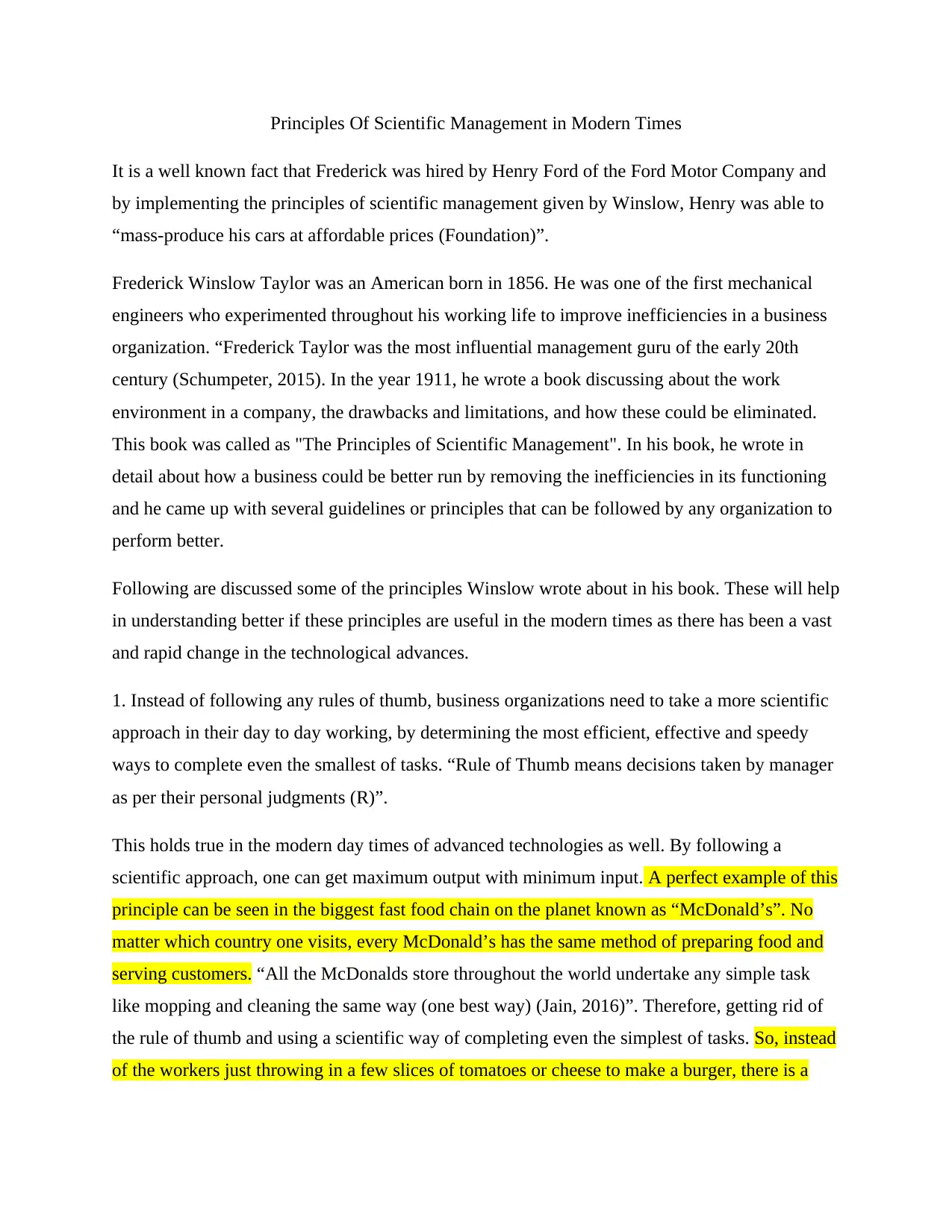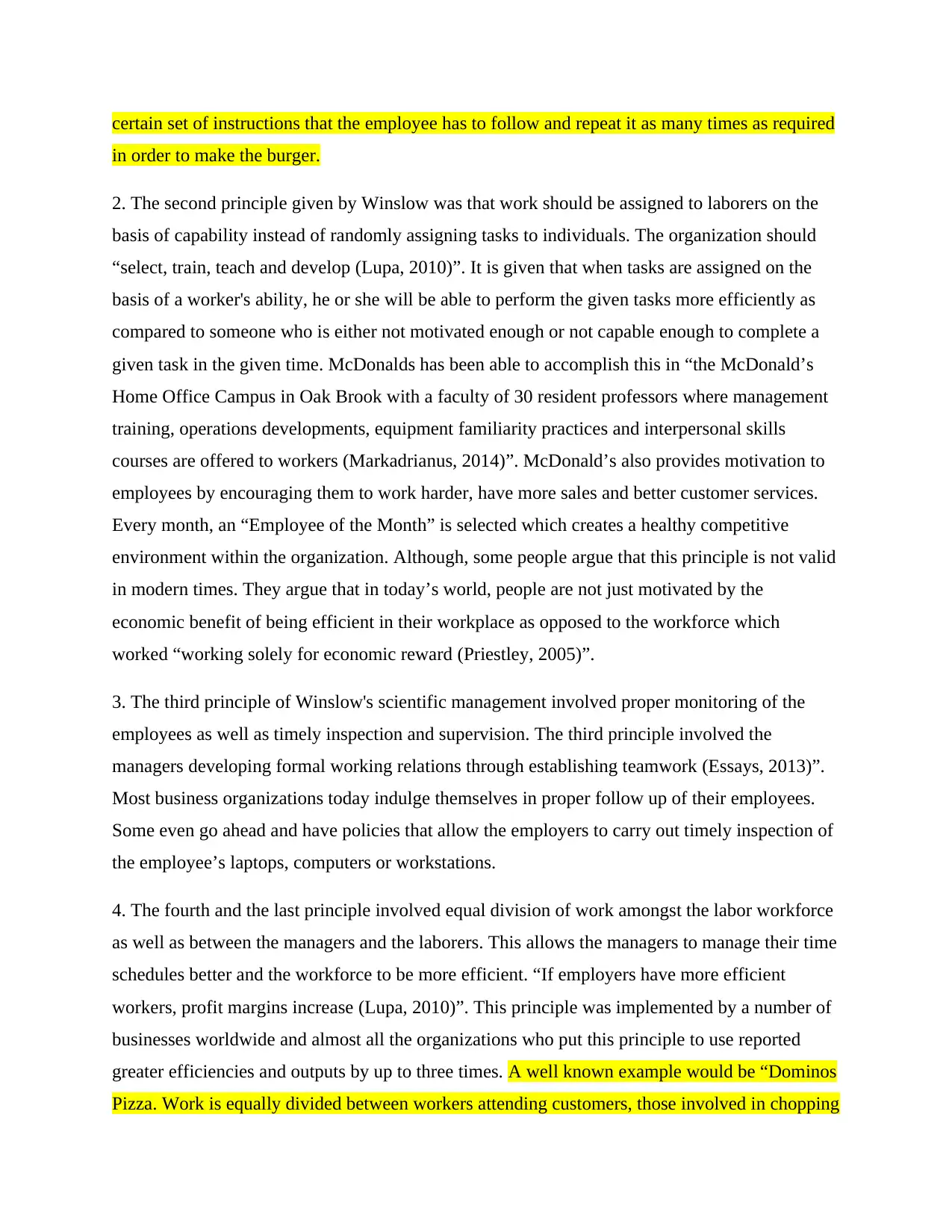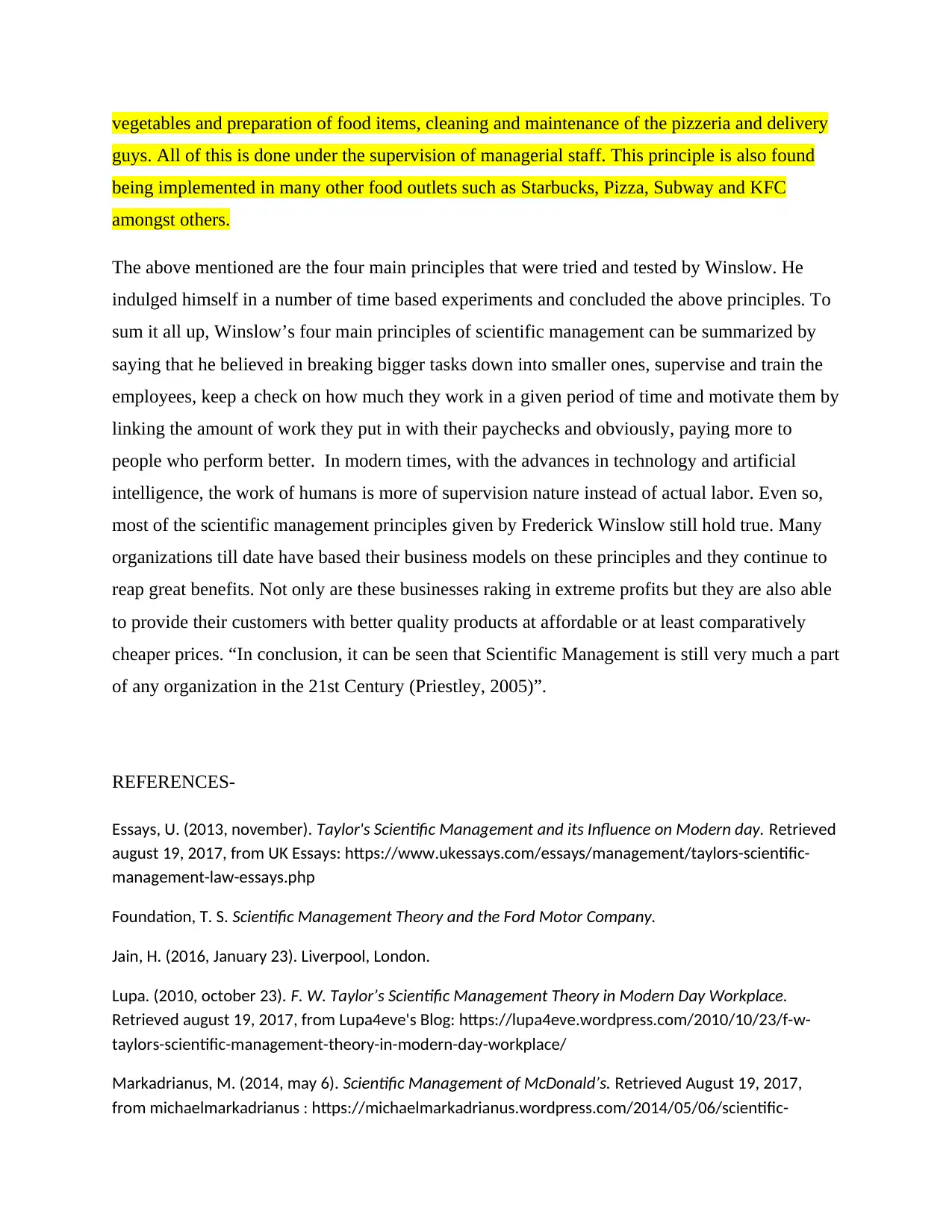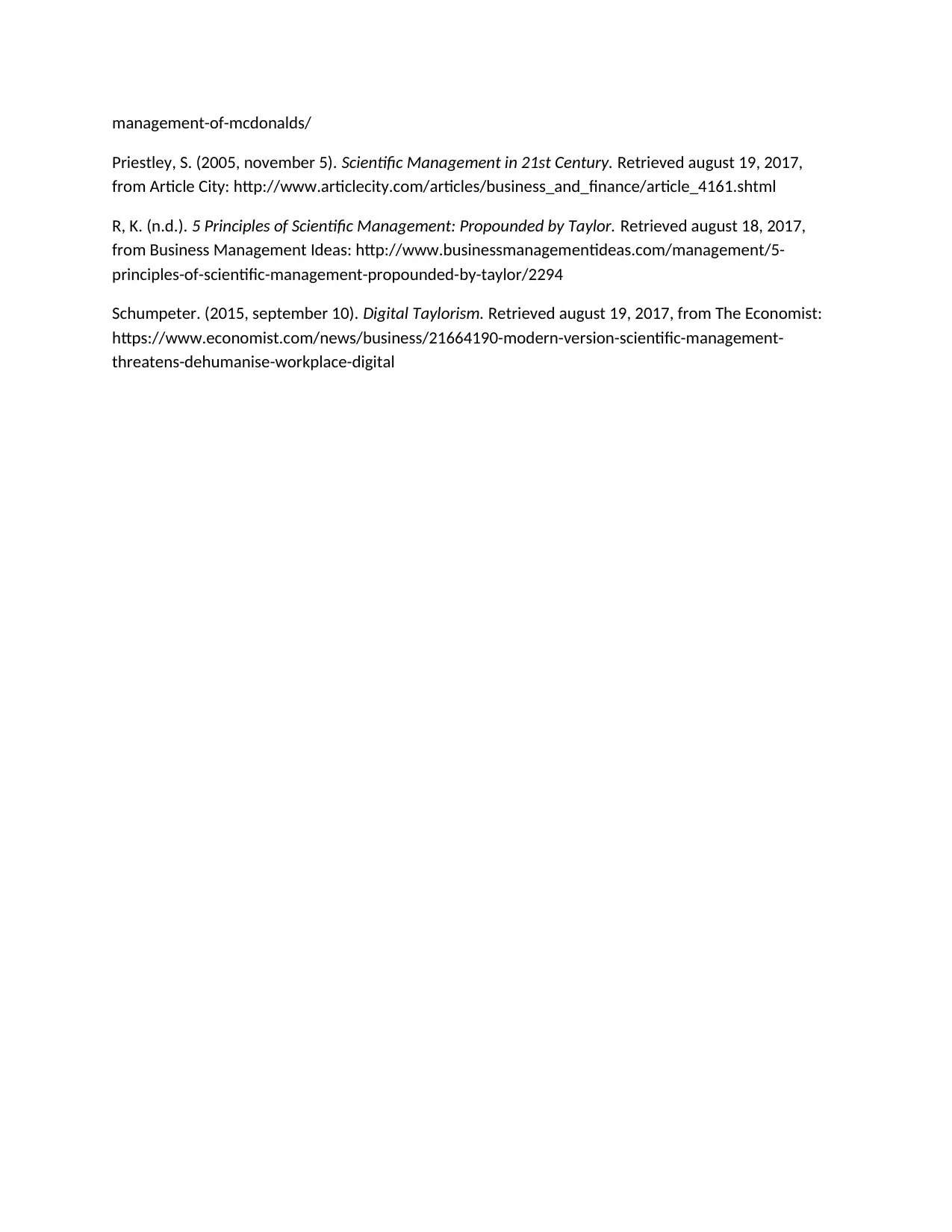Analysis: Principles of Scientific Management in the Modern Era
VerifiedAdded on 2020/03/04
|4
|1436
|66
Essay
AI Summary
This essay delves into the principles of scientific management as proposed by Frederick Winslow Taylor and assesses their continued relevance in contemporary business environments. It examines Taylor's core tenets, including the scientific approach to task design, the importance of worker selection and training, the necessity of employee monitoring and supervision, and the equitable division of labor. The essay uses real-world examples, such as McDonald's and Domino's Pizza, to illustrate how these principles are applied in practice. It acknowledges the evolution of work with technological advancements and artificial intelligence while arguing that Taylor's foundational ideas still provide a framework for improving efficiency, productivity, and customer satisfaction in modern organizations. The analysis emphasizes the enduring impact of scientific management on business models and its contribution to providing quality products and services at competitive prices.

Principles Of Scientific Management in Modern Times
It is a well known fact that Frederick was hired by Henry Ford of the Ford Motor Company and
by implementing the principles of scientific management given by Winslow, Henry was able to
“mass-produce his cars at affordable prices (Foundation)”.
Frederick Winslow Taylor was an American born in 1856. He was one of the first mechanical
engineers who experimented throughout his working life to improve inefficiencies in a business
organization. “Frederick Taylor was the most influential management guru of the early 20th
century (Schumpeter, 2015). In the year 1911, he wrote a book discussing about the work
environment in a company, the drawbacks and limitations, and how these could be eliminated.
This book was called as "The Principles of Scientific Management". In his book, he wrote in
detail about how a business could be better run by removing the inefficiencies in its functioning
and he came up with several guidelines or principles that can be followed by any organization to
perform better.
Following are discussed some of the principles Winslow wrote about in his book. These will help
in understanding better if these principles are useful in the modern times as there has been a vast
and rapid change in the technological advances.
1. Instead of following any rules of thumb, business organizations need to take a more scientific
approach in their day to day working, by determining the most efficient, effective and speedy
ways to complete even the smallest of tasks. “Rule of Thumb means decisions taken by manager
as per their personal judgments (R)”.
This holds true in the modern day times of advanced technologies as well. By following a
scientific approach, one can get maximum output with minimum input. A perfect example of this
principle can be seen in the biggest fast food chain on the planet known as “McDonald’s”. No
matter which country one visits, every McDonald’s has the same method of preparing food and
serving customers. “All the McDonalds store throughout the world undertake any simple task
like mopping and cleaning the same way (one best way) (Jain, 2016)”. Therefore, getting rid of
the rule of thumb and using a scientific way of completing even the simplest of tasks. So, instead
of the workers just throwing in a few slices of tomatoes or cheese to make a burger, there is a
It is a well known fact that Frederick was hired by Henry Ford of the Ford Motor Company and
by implementing the principles of scientific management given by Winslow, Henry was able to
“mass-produce his cars at affordable prices (Foundation)”.
Frederick Winslow Taylor was an American born in 1856. He was one of the first mechanical
engineers who experimented throughout his working life to improve inefficiencies in a business
organization. “Frederick Taylor was the most influential management guru of the early 20th
century (Schumpeter, 2015). In the year 1911, he wrote a book discussing about the work
environment in a company, the drawbacks and limitations, and how these could be eliminated.
This book was called as "The Principles of Scientific Management". In his book, he wrote in
detail about how a business could be better run by removing the inefficiencies in its functioning
and he came up with several guidelines or principles that can be followed by any organization to
perform better.
Following are discussed some of the principles Winslow wrote about in his book. These will help
in understanding better if these principles are useful in the modern times as there has been a vast
and rapid change in the technological advances.
1. Instead of following any rules of thumb, business organizations need to take a more scientific
approach in their day to day working, by determining the most efficient, effective and speedy
ways to complete even the smallest of tasks. “Rule of Thumb means decisions taken by manager
as per their personal judgments (R)”.
This holds true in the modern day times of advanced technologies as well. By following a
scientific approach, one can get maximum output with minimum input. A perfect example of this
principle can be seen in the biggest fast food chain on the planet known as “McDonald’s”. No
matter which country one visits, every McDonald’s has the same method of preparing food and
serving customers. “All the McDonalds store throughout the world undertake any simple task
like mopping and cleaning the same way (one best way) (Jain, 2016)”. Therefore, getting rid of
the rule of thumb and using a scientific way of completing even the simplest of tasks. So, instead
of the workers just throwing in a few slices of tomatoes or cheese to make a burger, there is a
Paraphrase This Document
Need a fresh take? Get an instant paraphrase of this document with our AI Paraphraser

certain set of instructions that the employee has to follow and repeat it as many times as required
in order to make the burger.
2. The second principle given by Winslow was that work should be assigned to laborers on the
basis of capability instead of randomly assigning tasks to individuals. The organization should
“select, train, teach and develop (Lupa, 2010)”. It is given that when tasks are assigned on the
basis of a worker's ability, he or she will be able to perform the given tasks more efficiently as
compared to someone who is either not motivated enough or not capable enough to complete a
given task in the given time. McDonalds has been able to accomplish this in “the McDonald’s
Home Office Campus in Oak Brook with a faculty of 30 resident professors where management
training, operations developments, equipment familiarity practices and interpersonal skills
courses are offered to workers (Markadrianus, 2014)”. McDonald’s also provides motivation to
employees by encouraging them to work harder, have more sales and better customer services.
Every month, an “Employee of the Month” is selected which creates a healthy competitive
environment within the organization. Although, some people argue that this principle is not valid
in modern times. They argue that in today’s world, people are not just motivated by the
economic benefit of being efficient in their workplace as opposed to the workforce which
worked “working solely for economic reward (Priestley, 2005)”.
3. The third principle of Winslow's scientific management involved proper monitoring of the
employees as well as timely inspection and supervision. The third principle involved the
managers developing formal working relations through establishing teamwork (Essays, 2013)”.
Most business organizations today indulge themselves in proper follow up of their employees.
Some even go ahead and have policies that allow the employers to carry out timely inspection of
the employee’s laptops, computers or workstations.
4. The fourth and the last principle involved equal division of work amongst the labor workforce
as well as between the managers and the laborers. This allows the managers to manage their time
schedules better and the workforce to be more efficient. “If employers have more efficient
workers, profit margins increase (Lupa, 2010)”. This principle was implemented by a number of
businesses worldwide and almost all the organizations who put this principle to use reported
greater efficiencies and outputs by up to three times. A well known example would be “Dominos
Pizza. Work is equally divided between workers attending customers, those involved in chopping
in order to make the burger.
2. The second principle given by Winslow was that work should be assigned to laborers on the
basis of capability instead of randomly assigning tasks to individuals. The organization should
“select, train, teach and develop (Lupa, 2010)”. It is given that when tasks are assigned on the
basis of a worker's ability, he or she will be able to perform the given tasks more efficiently as
compared to someone who is either not motivated enough or not capable enough to complete a
given task in the given time. McDonalds has been able to accomplish this in “the McDonald’s
Home Office Campus in Oak Brook with a faculty of 30 resident professors where management
training, operations developments, equipment familiarity practices and interpersonal skills
courses are offered to workers (Markadrianus, 2014)”. McDonald’s also provides motivation to
employees by encouraging them to work harder, have more sales and better customer services.
Every month, an “Employee of the Month” is selected which creates a healthy competitive
environment within the organization. Although, some people argue that this principle is not valid
in modern times. They argue that in today’s world, people are not just motivated by the
economic benefit of being efficient in their workplace as opposed to the workforce which
worked “working solely for economic reward (Priestley, 2005)”.
3. The third principle of Winslow's scientific management involved proper monitoring of the
employees as well as timely inspection and supervision. The third principle involved the
managers developing formal working relations through establishing teamwork (Essays, 2013)”.
Most business organizations today indulge themselves in proper follow up of their employees.
Some even go ahead and have policies that allow the employers to carry out timely inspection of
the employee’s laptops, computers or workstations.
4. The fourth and the last principle involved equal division of work amongst the labor workforce
as well as between the managers and the laborers. This allows the managers to manage their time
schedules better and the workforce to be more efficient. “If employers have more efficient
workers, profit margins increase (Lupa, 2010)”. This principle was implemented by a number of
businesses worldwide and almost all the organizations who put this principle to use reported
greater efficiencies and outputs by up to three times. A well known example would be “Dominos
Pizza. Work is equally divided between workers attending customers, those involved in chopping

vegetables and preparation of food items, cleaning and maintenance of the pizzeria and delivery
guys. All of this is done under the supervision of managerial staff. This principle is also found
being implemented in many other food outlets such as Starbucks, Pizza, Subway and KFC
amongst others.
The above mentioned are the four main principles that were tried and tested by Winslow. He
indulged himself in a number of time based experiments and concluded the above principles. To
sum it all up, Winslow’s four main principles of scientific management can be summarized by
saying that he believed in breaking bigger tasks down into smaller ones, supervise and train the
employees, keep a check on how much they work in a given period of time and motivate them by
linking the amount of work they put in with their paychecks and obviously, paying more to
people who perform better. In modern times, with the advances in technology and artificial
intelligence, the work of humans is more of supervision nature instead of actual labor. Even so,
most of the scientific management principles given by Frederick Winslow still hold true. Many
organizations till date have based their business models on these principles and they continue to
reap great benefits. Not only are these businesses raking in extreme profits but they are also able
to provide their customers with better quality products at affordable or at least comparatively
cheaper prices. “In conclusion, it can be seen that Scientific Management is still very much a part
of any organization in the 21st Century (Priestley, 2005)”.
REFERENCES-
Essays, U. (2013, november). Taylor's Scientific Management and its Influence on Modern day. Retrieved
august 19, 2017, from UK Essays: https://www.ukessays.com/essays/management/taylors-scientific-
management-law-essays.php
Foundation, T. S. Scientific Management Theory and the Ford Motor Company.
Jain, H. (2016, January 23). Liverpool, London.
Lupa. (2010, october 23). F. W. Taylor’s Scientific Management Theory in Modern Day Workplace.
Retrieved august 19, 2017, from Lupa4eve's Blog: https://lupa4eve.wordpress.com/2010/10/23/f-w-
taylors-scientific-management-theory-in-modern-day-workplace/
Markadrianus, M. (2014, may 6). Scientific Management of McDonald’s. Retrieved August 19, 2017,
from michaelmarkadrianus : https://michaelmarkadrianus.wordpress.com/2014/05/06/scientific-
guys. All of this is done under the supervision of managerial staff. This principle is also found
being implemented in many other food outlets such as Starbucks, Pizza, Subway and KFC
amongst others.
The above mentioned are the four main principles that were tried and tested by Winslow. He
indulged himself in a number of time based experiments and concluded the above principles. To
sum it all up, Winslow’s four main principles of scientific management can be summarized by
saying that he believed in breaking bigger tasks down into smaller ones, supervise and train the
employees, keep a check on how much they work in a given period of time and motivate them by
linking the amount of work they put in with their paychecks and obviously, paying more to
people who perform better. In modern times, with the advances in technology and artificial
intelligence, the work of humans is more of supervision nature instead of actual labor. Even so,
most of the scientific management principles given by Frederick Winslow still hold true. Many
organizations till date have based their business models on these principles and they continue to
reap great benefits. Not only are these businesses raking in extreme profits but they are also able
to provide their customers with better quality products at affordable or at least comparatively
cheaper prices. “In conclusion, it can be seen that Scientific Management is still very much a part
of any organization in the 21st Century (Priestley, 2005)”.
REFERENCES-
Essays, U. (2013, november). Taylor's Scientific Management and its Influence on Modern day. Retrieved
august 19, 2017, from UK Essays: https://www.ukessays.com/essays/management/taylors-scientific-
management-law-essays.php
Foundation, T. S. Scientific Management Theory and the Ford Motor Company.
Jain, H. (2016, January 23). Liverpool, London.
Lupa. (2010, october 23). F. W. Taylor’s Scientific Management Theory in Modern Day Workplace.
Retrieved august 19, 2017, from Lupa4eve's Blog: https://lupa4eve.wordpress.com/2010/10/23/f-w-
taylors-scientific-management-theory-in-modern-day-workplace/
Markadrianus, M. (2014, may 6). Scientific Management of McDonald’s. Retrieved August 19, 2017,
from michaelmarkadrianus : https://michaelmarkadrianus.wordpress.com/2014/05/06/scientific-
⊘ This is a preview!⊘
Do you want full access?
Subscribe today to unlock all pages.

Trusted by 1+ million students worldwide

management-of-mcdonalds/
Priestley, S. (2005, november 5). Scientific Management in 21st Century. Retrieved august 19, 2017,
from Article City: http://www.articlecity.com/articles/business_and_finance/article_4161.shtml
R, K. (n.d.). 5 Principles of Scientific Management: Propounded by Taylor. Retrieved august 18, 2017,
from Business Management Ideas: http://www.businessmanagementideas.com/management/5-
principles-of-scientific-management-propounded-by-taylor/2294
Schumpeter. (2015, september 10). Digital Taylorism. Retrieved august 19, 2017, from The Economist:
https://www.economist.com/news/business/21664190-modern-version-scientific-management-
threatens-dehumanise-workplace-digital
Priestley, S. (2005, november 5). Scientific Management in 21st Century. Retrieved august 19, 2017,
from Article City: http://www.articlecity.com/articles/business_and_finance/article_4161.shtml
R, K. (n.d.). 5 Principles of Scientific Management: Propounded by Taylor. Retrieved august 18, 2017,
from Business Management Ideas: http://www.businessmanagementideas.com/management/5-
principles-of-scientific-management-propounded-by-taylor/2294
Schumpeter. (2015, september 10). Digital Taylorism. Retrieved august 19, 2017, from The Economist:
https://www.economist.com/news/business/21664190-modern-version-scientific-management-
threatens-dehumanise-workplace-digital
1 out of 4
Related Documents
Your All-in-One AI-Powered Toolkit for Academic Success.
+13062052269
info@desklib.com
Available 24*7 on WhatsApp / Email
![[object Object]](/_next/static/media/star-bottom.7253800d.svg)
Unlock your academic potential
Copyright © 2020–2025 A2Z Services. All Rights Reserved. Developed and managed by ZUCOL.




